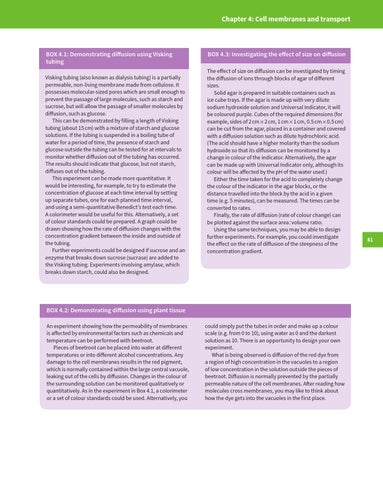Chapter 4: Cell membranes and transport
BOX 4.1: Demonstrating diffusion using Visking tubing Visking tubing (also known as dialysis tubing) is a partially permeable, non-living membrane made from cellulose. It possesses molecular-sized pores which are small enough to prevent the passage of large molecules, such as starch and sucrose, but will allow the passage of smaller molecules by diffusion, such as glucose. This can be demonstrated by filling a length of Visking tubing (about 15 cm) with a mixture of starch and glucose solutions. If the tubing is suspended in a boiling tube of water for a period of time, the presence of starch and glucose outside the tubing can be tested for at intervals to monitor whether diffusion out of the tubing has occurred. The results should indicate that glucose, but not starch, diffuses out of the tubing. This experiment can be made more quantitative. It would be interesting, for example, to try to estimate the concentration of glucose at each time interval by setting up separate tubes, one for each planned time interval, and using a semi-quantitative Benedict’s test each time. A colorimeter would be useful for this. Alternatively, a set of colour standards could be prepared. A graph could be drawn showing how the rate of diffusion changes with the concentration gradient between the inside and outside of the tubing. Further experiments could be designed if sucrose and an enzyme that breaks down sucrose (sucrase) are added to the Visking tubing. Experiments involving amylase, which breaks down starch, could also be designed.
BOX 4.3: Investigating the effect of size on diffusion The effect of size on diffusion can be investigated by timing the diffusion of ions through blocks of agar of different sizes. Solid agar is prepared in suitable containers such as ice cube trays. If the agar is made up with very dilute sodium hydroxide solution and Universal Indicator, it will be coloured purple. Cubes of the required dimensions (for example, sides of 2 cm × 2 cm, 1 cm × 1 cm, 0.5 cm × 0.5 cm) can be cut from the agar, placed in a container and covered with a diffusion solution such as dilute hydrochloric acid. (The acid should have a higher molarity than the sodium hydroxide so that its diffusion can be monitored by a change in colour of the indicator. Alternatively, the agar can be made up with Universal Indicator only, although its colour will be affected by the pH of the water used.) Either the time taken for the acid to completely change the colour of the indicator in the agar blocks, or the distance travelled into the block by the acid in a given time (e.g. 5 minutes), can be measured. The times can be converted to rates. Finally, the rate of diffusion (rate of colour change) can be plotted against the surface area : volume ratio. Using the same techniques, you may be able to design further experiments. For example, you could investigate the effect on the rate of diffusion of the steepness of the concentration gradient.
BOX 4.2: Demonstrating diffusion using plant tissue An experiment showing how the permeability of membranes is affected by environmental factors such as chemicals and temperature can be performed with beetroot. Pieces of beetroot can be placed into water at different temperatures or into different alcohol concentrations. Any damage to the cell membranes results in the red pigment, which is normally contained within the large central vacuole, leaking out of the cells by diffusion. Changes in the colour of the surrounding solution can be monitored qualitatively or quantitatively. As in the experiment in Box 4.1, a colorimeter or a set of colour standards could be used. Alternatively, you
could simply put the tubes in order and make up a colour scale (e.g. from 0 to 10), using water as 0 and the darkest solution as 10. There is an opportunity to design your own experiment. What is being observed is diffusion of the red dye from a region of high concentration in the vacuoles to a region of low concentration in the solution outside the pieces of beetroot. Diffusion is normally prevented by the partially permeable nature of the cell membranes. After reading how molecules cross membranes, you may like to think about how the dye gets into the vacuoles in the first place.
81
